Harold Davis's Blog, page 70
May 19, 2019
The Scallop Shell Symbol on the Camino
If you’ve walked the Camino de Santiago, you’ll have followed a route marked with scallop shell symbols. Along with many other pilgrims, I have a scallop shell hanging from my pack to let others know I am walking a Camino. Walking along, I keep my eye out for the scallop shell symbol, and note cafes, albergues, and other services that use the scallop shell as a sign that these places are hospitable and friendly to itinerant pilgrims.
But when you think about it, the scallop shell seems like an odd symbol to represent the path of the Camino, the most traveled pilgrimage route in all of christendom. The scallop shell seems distinctly peculiar as a christian or Catholic symbol when we have come to expect a crucifix, or perhaps the Madonna.

Scallop Shell Symbol on the Side of the Cathedral of Santiago © Harold Davis
So where did the scallop shell symbol come from? If you look at the history of the Catholic church, it is very common for pagan beliefs and symbolism to be absorbed and incorporated into doctrines and practices. The adoption of the scallop shell symbol is a prime example.
Back in the times of the Greeks and Romans, the scallop shell was a symbol of the Goddess Aphrodite, Venus to the Romans. In the Roman era, an important ritual began at the Temple of Venus near the forum in Rome, and continued in some cases with a spiritual journey to the Atlantic coast of Galicia.
This journey encompassed fertility rituals invoking Venus along the way, and was also sacred to the two-faced God, Janus. Janus was the God of beginnings, transitions, transformations, doors, and endings: all highly relevant to pilgrimages and pilgrims.
A gift of walking a Camino is the encounters and conversations with folks from all walks of life and many parts of the world who are looking out for each other. It is astounding to realize as one walks the Camino that one is part of a tradition the predates Christianity, and speaks to the common humanity and ability of all of us to get along together.

Scallop Shell Manhole © Harold Davis

May 18, 2019
Cathedral of Santiago de Compostela at Sunrise
For well over a millennia, the Cathedral of Saint James has been the goal of a tireless—and tired and footsore—stream of pilgrims toiling along the various Caminos that lead to Santiago de Compostela. The Cathedral is shown here in the distance by the first light of dawn. It is “brought closer” since I used a 300mm telephoto focal length lens.
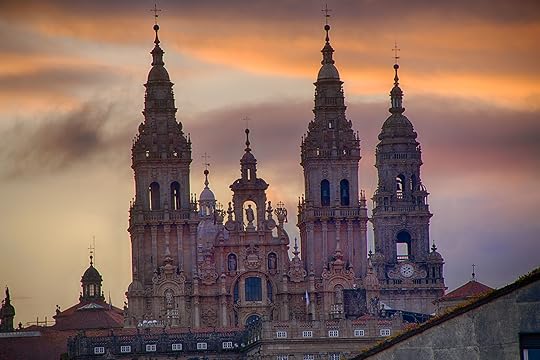
Cathedral of Santiago de Compostela at Sunrise © Harold Davis

May 16, 2019
Garden along the Camino
Someone had built this garden beside the trail in the nook beside an old stone wall, with its rose trellis across a small spring. Now, half wild, the garden was reclaiming its heritage—and like the ancient land of the Camino was part way reverted to its natural state.

Garden along the Camino © Harold Davis

May 14, 2019
Blue Arrow and Yellow Arrow
The algorithm for following one of the pilgrimage trails to Santiago de Compostela is really pretty simple: follow the yellow arrows, or the well-known Camino clamshell trail markers. If you go 100 meters without seeing a yellow arrow or a clamshell, maybe you made a wrong turn. Go back to the last place you saw a marker or arrow, and look around carefully. It can be a little hard to see the symbols when the trail goes through a busy city, but basically if you stick to this process you can’t go wrong.
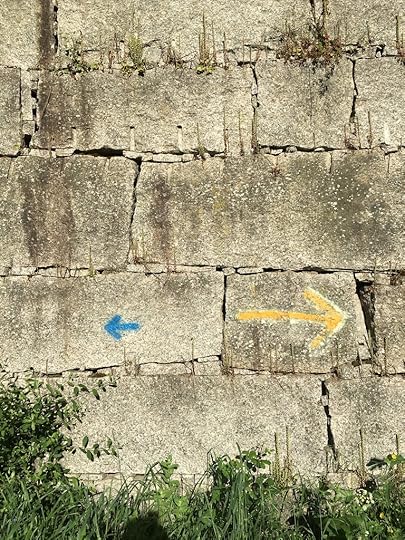
Blue and Yellow Arrow © Harold Davis
The Camino Portuguese heads north from Portugal to Santiago de Compostela in Galicia, Spain. In contrast, the pilgrimage to Our Lady of Fatima heads south to Fatima, which is about 100 KM north of Lisbon in Portugal. So the two pilgrimages go in opposite directions. The Camino Portuguese is marked, as I’ve noted, with yellow arrows. The Fatima pilgrimage is marked with blue arrows. It’s not unusual depending on the time of year to see pilgrims along the routes going in both directions, one group following the yellow arrows, and the other following the blue arrows, each set of pilgrims walking in the exact opposite direction of the other pilgrimage.

May 13, 2019
Ponte Sampaio
Built on a Roman foundation, the Ponte Sampaio is the site of a decisive battle to liberate Galicia from Napoleon’s French army under Marshal Ney in 1809. For more on the complex history of those times, check out the Wikipedia article that provides an overview of the Peninsular War.
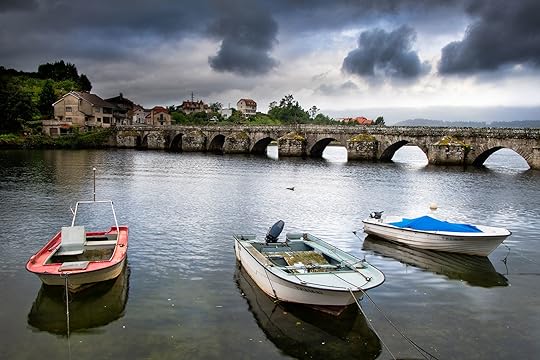
Ponte Sampaio © Harold Davis

May 11, 2019
Did the Serpent Get a ‘Bum Rap’?
I think the serpent may have gotten a bum rap. At the very least, there is some indignity to an honest snake for being depicted as a kind of lizard with front legs, and knotted into a pretzel shape. Where is Eve in all this, and why would she listen to this critter?

Did the serpent get a ‘bad rap’? © Harold Davis

Seen Along the Way of Saint James
Here are a few random sightings captured with my iPhone camera on the Way of Saint James, specifically the Camino Portuguese, on my walk through southern Galicia towards Santiago.

Pilgrim Church © Harold Davis
Above, the interior dome and chandelier of the Pilgrim Church—Capela da Virxe Peregrina—in Pontevedra. It was fun climbing to the top of the dome, which I did after making this photo and getting my Pilgrim book stamped.
Below, the alternate Camino passes through a tunnel under train tracks beside a small river. If the Way seems narrow in the photo, indeed it was!
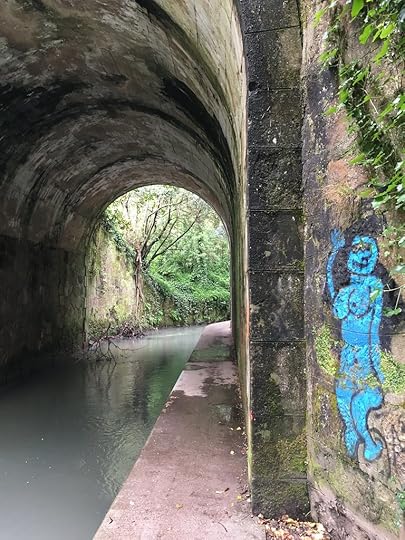
Tunnel on the Camino © Harold Davis
Finally, walking through the gritty outskirts of Arcade, a witch is seen rising before the moon on her broomstick. The circular moon is of course echoed in the heating unit that appears above the witch.
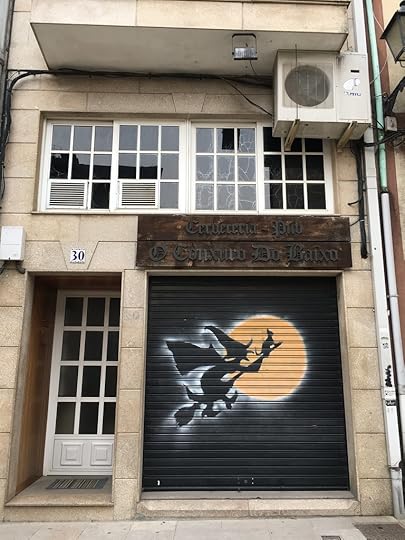
Witch © Harold Davis

May 9, 2019
Last Gas
I found this signage advertising the “latest” bar on the Camino Portuguese shortly before the Spanish border where the great pilgrimage trail crosses the River Minho to Tui, Spain. By “latest” I’m pretty sure that they meant “last”—so this is one of those signs like “last gas in Nevada.” Does one really care? Are the bars in Spain so different from those in Portugal? Experience tells me: not so much.

Last Gas © Harold Davis

Roman Bridges of Galicia
There are literally hundreds of Roman bridges in Galicia, many used by or adjacent to the Camino Portuguese.
Some of these are more recent constructions on the Roman-engineered foundations, but with other the literal stones of the bridges date back millennia. The Oronelle Bridge, shown below, was built by the Romans, and is still quite usable,
It’s amazing to see the grooves in the stones worn by cart wheels and foot tread over the vast span of years!
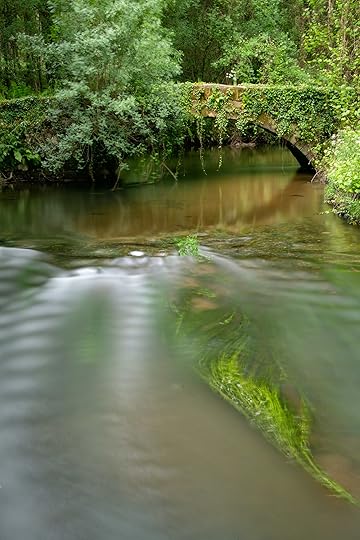
Oronelle Bridge © Harold Davis

May 8, 2019
Inside Tui Cathedral and I Have a Bilbo Baggins Moment
Tui Cathedral is nominally the starting point for my Camino. This is where my pilgrimage begins. The distances are calculated from the doors of the Cathedral.
Inside, the Cathedral is a heady and eclectic blend of Gothic, Romanesque, and Baroque styles. In the image, the double organs across each side of the nave is something I’ve never seen anywhere else. In addition, the Cathedral was a frontier fortress with battlements, terraces, and a fortified cloisters, on active alert across the River Minho facing the “enemy” fortress on the other side for centuries.

Inside Tui Cathedral © Harold Davis
This morning I had my “Bilbo Baggins” moment. A somewhat portly, middle-aged gent, I checked out of the hotel, leaving my key at the front desk, slipped on my pack and headed across the meadow to the trail. Oh, the moment was slightly spoiled when I had to adjust the lacing on my boots before getting started (hobbits don’t wear shoes of course).
The sky was gray with storm-wracked clouds and the forecast was for wet weather. Instead of worrying about a pocket handkerchief as Bilbo famously did, I wondered whether my the rain cover for my pack was handy.




